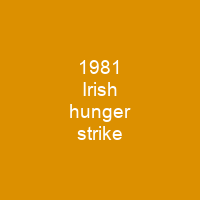The 1981 Irish hunger strike was the culmination of a five-year protest by Irish republican prisoners in Northern Ireland. The protest began as the blanket protest in 1976, when the British government withdrew Special Category Status for convicted paramilitary prisoners. In 1978, the dispute escalated into the dirty protest, where prisoners refused to leave their cells to wash and covered the walls of their cells with excrement. In 1980, seven prisoners participated in the first hunger strike, which ended after 53 days. The second hunger strike took place in 1981 and was a showdown between the prisoners and the Prime Minister, Margaret Thatcher. One hunger striker, Bobby Sands, was elected as a member of parliament during the strike, prompting media interest from around the world.
About 1981 Irish hunger strike in brief
 The 1981 Irish hunger strike was the culmination of a five-year protest by Irish republican prisoners in Northern Ireland. The protest began as the blanket protest in 1976, when the British government withdrew Special Category Status for convicted paramilitary prisoners. In 1978, the dispute escalated into the dirty protest, where prisoners refused to leave their cells to wash and covered the walls of their cells with excrement. In 1980, seven prisoners participated in the first hunger strike, which ended after 53 days. The second hunger strike took place in 1981 and was a showdown between the prisoners and the Prime Minister, Margaret Thatcher. One hunger striker, Bobby Sands, was elected as a member of parliament during the strike, prompting media interest from around the world. The strike was called off after ten prisoners had starved themselves to death, including Sands, whose funeral was attended by 100,000 people. It radicalised Irish nationalist politics, and was the driving force that enabled Sinn Féin to become a mainstream political party. The period leading up to the hunger strike saw assassinations by both republicans and loyalists. The IRA shot and killed a number of prison officers, loyalist paramilitaries and activists in the National H-BlockArmagh Committee while badly injured in an attempt on their lives. On 27 October 1980, republican prisoners began a hunger strike in HM Prison Maze. One hundred prisoners volunteered to be part of the strike and forty-eight were selected to match the number of men who signed the Easter 1916 Proclamation of the Republic.
The 1981 Irish hunger strike was the culmination of a five-year protest by Irish republican prisoners in Northern Ireland. The protest began as the blanket protest in 1976, when the British government withdrew Special Category Status for convicted paramilitary prisoners. In 1978, the dispute escalated into the dirty protest, where prisoners refused to leave their cells to wash and covered the walls of their cells with excrement. In 1980, seven prisoners participated in the first hunger strike, which ended after 53 days. The second hunger strike took place in 1981 and was a showdown between the prisoners and the Prime Minister, Margaret Thatcher. One hunger striker, Bobby Sands, was elected as a member of parliament during the strike, prompting media interest from around the world. The strike was called off after ten prisoners had starved themselves to death, including Sands, whose funeral was attended by 100,000 people. It radicalised Irish nationalist politics, and was the driving force that enabled Sinn Féin to become a mainstream political party. The period leading up to the hunger strike saw assassinations by both republicans and loyalists. The IRA shot and killed a number of prison officers, loyalist paramilitaries and activists in the National H-BlockArmagh Committee while badly injured in an attempt on their lives. On 27 October 1980, republican prisoners began a hunger strike in HM Prison Maze. One hundred prisoners volunteered to be part of the strike and forty-eight were selected to match the number of men who signed the Easter 1916 Proclamation of the Republic.
The group consisted of IRA members of Brendan Hughes, Raymond McKearney, Tom McFeeley, Raymond McCartney, Tommy McCartney, Sean McKenna, and Tommy Hughes. On 1 December three prisoners in Armagh’s Women’s Prison followed by several more dozen more prisoners. The hunger strike ended after a short-lived hunger strike by several prisoners in HM Maze, including Mairéad Farrell, John Nixon, John Green, Sean Green, Leo Green, and Sean McKenna. The use of a hungerstrike as a means of protest in Ireland is a tradition dating to pre-Christian times. There had been hunger strikes by Irish Republican prisoners since 1917, and twelve men had previously died on hunger strike. The twelve included Thomas Ashe, Terence MacSwiney, Michael Fitzgerald, Joe Murphy, Denny Barry, Seán McCaughey, Michael Gaughan and Frank Stagg. In 1979, former MP Bernadette McAliskey stood in the election for the European Parliament on a platform of support for the protesting prisoners, and won 5.9% of the vote across Northern Ireland, even though Sinn FÉin had called for a boycott of the election. The protests aimed to re-establish their political status by securing what were known as the \”Five Demands\”, with McAl iskey as its main spokesperson. In July 1972, when Special Category status was introduced, prisoners were refused the same rights as internees until July 1972. The policy was not introduced for existing prisoners, but for those convicted of offences after 1 March 1976.
You want to know more about 1981 Irish hunger strike?
This page is based on the article 1981 Irish hunger strike published in Wikipedia (as of Dec. 03, 2020) and was automatically summarized using artificial intelligence.







